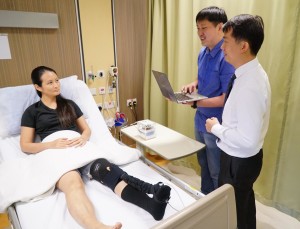A team at the National University of Singapore (NUS) is looking for industry partners to help take their air-conditioning technology from the laboratory to the marketplace. First, here’s more about the technology from a January 8, 2018 news item on ScienceDaily,
A team of researchers from the National University of Singapore (NUS) has pioneered a new water-based air-conditioning system that cools air to as low as 18 degrees Celsius without the use of energy-intensive compressors and environmentally harmful chemical refrigerants. This game-changing technology could potentially replace the century-old air-cooling principle that is still being used in our modern-day air-conditioners. Suitable for both indoor and outdoor use, the novel system is portable and it can also be customised for all types of weather conditions.
A January 8, 2018 NUS press release offers additional technical detail and includes call for industrial partners,
NUS Engineering researchers developed a novel air cooling technology that could redefine the future of air-conditioning.
Led by Associate Professor Ernest Chua from the Department of Mechanical Engineering at NUS Faculty of Engineering, the team’s novel air-conditioning system is cost-effective to produce, and it is also more eco-friendly and sustainable. The system consumes about 40 per cent less electricity than current compressor-based air-conditioners used in homes and commercial buildings. This translates into more than 40 per cent reduction in carbon emissions. In addition, it adopts a water-based cooling technology instead of using chemical refrigerants such as chlorofluorocarbon and hydrochlorofluorocarbon for cooling, thus making it safer and more environmentally-friendly.
To add another feather to its eco-friendliness cap, the novel system generates potable drinking water while it cools ambient air.
Assoc Prof Chua said, “For buildings located in the tropics, more than 40 per cent of the building’s energy consumption is attributed to air-conditioning. We expect this rate to increase dramatically, adding an extra punch to global warming. First invented by Willis Carrier in 1902, vapour compression air-conditioning is the most widely used air-conditioning technology today. This approach is very energy-intensive and environmentally harmful. In contrast, our novel membrane and water-based cooling technology is very eco-friendly – it can provide cool and dry air without using a compressor and chemical refrigerants. This is a new starting point for the next generation of air-conditioners, and our technology has immense potential to disrupt how air-conditioning has traditionally been provided.”
Innovative membrane and water-based cooling technology
Current air-conditioning systems require a large amount of energy to remove moisture and to cool the dehumidified air. By developing two systems to perform these two processes separately, the NUS Engineering team can better control each process and hence achieve greater energy efficiency.
The novel air-conditioning system first uses an innovative membrane technology – a paper-like material – to remove moisture from humid outdoor air. The dehumidified air is then cooled via a dew-point cooling system that uses water as the cooling medium instead of harmful chemical refrigerants. Unlike vapour compression air-conditioners, the novel system does not release hot air to the environment. Instead, a cool air stream that is comparatively less humid than environmental humidity is discharged – negating the effect of micro-climate. About 12 to 15 litres of potable drinking water can also be harvested after operating the air-conditioning system for a day.
“Our cooling technology can be easily tailored for all types of weather conditions, from humid climate in the tropics to arid climate in the deserts. While it can be used for indoor living and commercial spaces, it can also be easily scaled up to provide air-conditioning for clusters of buildings in an energy-efficient manner. This novel technology is also highly suitable for confined spaces such as bomb shelters or bunkers, where removing moisture from the air is critical for human comfort, as well as for sustainable operation of delicate equipment in areas such as field hospitals, armoured personnel carriers, and operation decks of navy ships as well as aircrafts,” explained Assoc Prof Chua.
The research team is currently refining the design of the air-conditioning system to further improve its user-friendliness. The NUS researchers are also working to incorporate smart features such as pre-programmed thermal settings based on human occupancy and real-time tracking of its energy efficiency. The team hopes to work with industry partners to commercialise the technology. [emphasis mine]
This project is supported by the Building and Construction Authority and National Research Foundation Singapore.
I’m sorry they didn’t include a link to a published paper but I gather that at this time there’s more focus on commercializing the technology than on published papers. I wish the researchers good luck as this cooling technology affords some exciting possibilities in a world that is heating and growing more parched as the NUS press release.notes

